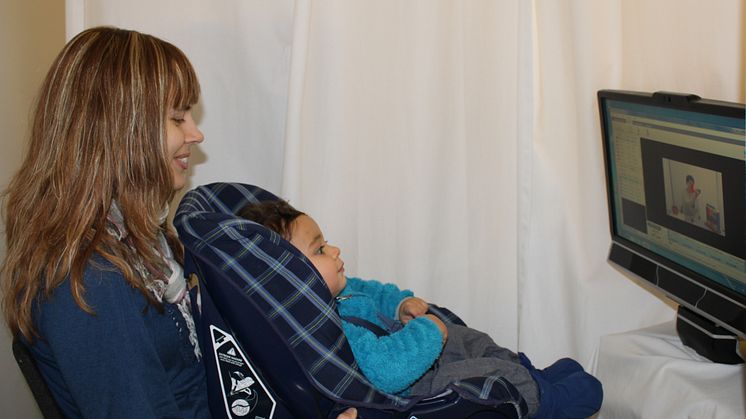
Press release -
Reduced attention to audiovisual synchrony in infancy predicts autism diagnosis at three years of age
A new study in the Journal of Child Psychology and Psychiatry suggests that infants who pay little attention to synchronous sights and sounds may be at elevated risk for developing autism spectrum disorder (ASD). This knowledge about early development in ASD may contribute to earlier detection and intervention in the future.
An ability to integrate information from different sensory modalities is important for infants development and for their perception of the environment. In the new study the researchers let the infants observe a computer screen on which half of the screen showed object that moved in synchrony with a sound and the other half showed objects that moved without any relation to the sound. The participants who fulfilled criteria for ASD at three years of age looked equally long at both sides, while children with typical development showed a strong preference for audiovisual synchrony, defined as changes in object velocity happening at the same time as changes in sound volume.
“We expected an effect in this direction, but were nevertheless surprised to see that the group differences were so large,” says Terje Falck-Ytter, Associate Professor at the Department of Psychology and Principal Investigator for the study. “We believe the findings are important because they point to a rather basic function that has not been studied much earlier in this context.”
The study is a part of the larger project Early Autism Sweden (EASE) (www.smasyskon.se), which is a collaboration between Uppsala University and the Center of Neurodevelopmental Disorders at Karolinska Institutet (KIND). The project includes younger siblings of children with ASD, ADHD or language disorder. The infants are followed longitudinally from five months of age until they reach six years. The participants in the current experiment were 10 months old when their visual preferences were examined and were followed until three years, when the diagnostic evaluation was conducted. In total, 33 infants with an older sibling with ASD took part in the study, of whom thirteen met criteria for ASD at follow-up. The study also included a control group consisting of fourteen infants at low (average) risk for ASD.
“Currently, ASD cannot be reliably diagnosed before 2–3 years of age, and despite a lot of research we still know too little about the causes. Even if twin studies suggest that genetic factors play an important role, we still do not know enough about which specific genes are involved and how they affect the developing brain to cause ASD. Our philosophy is that studying the early development of ASD will help clarify the picture,” Falck-Ytter explains.
The results demonstrated significant group differences, but it is too early to say whether the method in its current form can facilitate early detection in a clinical context.
“We used eye tracking to measure the infants’ gaze, and the experiment lasted only a few minutes. It is of course fascinating and promising that one can forecast with some degree of accuracy how a child will develop based on such a short measurement of gaze patterns. At the same time it is important to bear in mind that significant results at the group level do not imply that one can take this eye tracking ‘test’ and get accurate results on an individual level,” says Falck-Ytter.
Falck-Ytter, T., Nyström, P., Gredebäck, G., Gliga, T., Bölte S. and the EASE team. (2018). Reduced orienting to audiovisual synchrony in infancy predicts autism diagnosis at 3 years of age. Journal of Child Psychology and Psychiatry. doi:10.1111/jcpp.12863
For more information, contact Terje Falck-Ytter, tel 070-458 14 75, e-post: terje.falck-ytter@psyk.uu.se
Topics
Uppsala University -- quality, knowledge, and creativity since 1477
World-class research and outstanding education of global benefit to society, business, and culture.
Uppsala University is one of northern Europe's highest ranked academic institutions. www.uu.se
